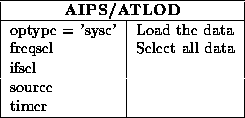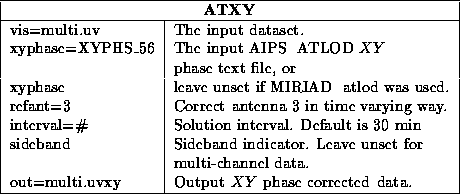XYPHS_ xx, where xx is your AIPS
number)
containing the XY
phase for each antenna into the FITS area (
/DATA/FITS). Text files of system temperature are also written.
Although the various selection parameters of ATLOD
are still active,
you probably want to see all the data. Most of the other ATLOD
parameters are unimportant for this.

You should plot the phases (and the system temperatures) with the Unix program pltsys -- which prompts you for the name of the text file to plot as well as other information. Examine these plots carefully to assess their quality. You should use these plots to choose your reference antenna (for calibration purposes). Choose the reference antenna to be the antenna having the cleanest, most stable XY phase measurements.
Determine some mean value of the XY phase for each antenna from the plots. The command pltsys prints out both the average and median XY phase. As there are often outliers, the median is more likely to reflect the true XY phase value. Getting a good value is only important for the reference antenna. Do not be too concerned if there are large jumps in the XY phases on antennas other than the reference antenna.
 a.
a.
phase of the reference antenna. Your choice will depend on taste, circumstances and the quality of the XY phase measurements. There are three main options:
- Correct using the MIRIAD
task atxy
(described later). This
is generally the best option.
This allows you to correct for the
variation of XY
phase with time. This will be essential if there is
significant time variability. To use this approach, you
will need to keep a copy of your XY
phase text file,
XYPHS_xx. - Correct in AIPS ATLOD . This has been the approach once recommended, and is still useful if the XY phase of at least one antenna is quite constant with time. It also has the advantage of getting the XY correction step over and done with early. However the user input can be error prone and tedious if the observation switches frequency with time.
- When only XX and YY correlations have been measured, absolute XY phase becomes irrelevant. Indeed it is not measured. In this case you do not need to apply any XY phase correction.
If you are going to correct the XY phases in MIRIAD , or if you are not going to correct XY phase at all, then you should now load your data without applying any XY phase. It is probably worth your while to pretend that the polarisations are circular rather than linear with the usual fudges, as not all the AIPS software will recognize linears (most of the calibration software will). You must not convert to Stokes parameters. The appropriate ATLOD parameters are

 b.
b.

For continuum work, to save disk space and to speed access to the data, you may consider averaging your channels together to form ``channel-0'' datasets, using task AVSPC . While this causes very little degradation for 3 cm observations, forming ``channel-0'' results in bandwidth smearing in 13 and 20 cm observations, and so is probably inadvisable for high dynamic range work there. For high dynamic range work at 6 cm, it is debatable whether averaging is detrimental. If in doubt, do not average. It is always possible to form a channel-0 dataset later anyway.
One other consideration in determining whether or not to average is whether
or not you are going to apply XY
phase corrections with task atxy
.
For obscure reasons, if you used AIPS
ATLOD
,
atxy
needs to know the ``sideband indicator''
of the data. The sideband indicator, which is  , is copiously
reported by ATLOD
, both in its output to the terminal, and in the
history file. The sideband indicator also happens to be the sign of the
channel frequency increment. This is how atxy
normally determines
them.
However, if you form a channel-0 dataset, the sign
of the frequency increment is lost! So if you give atxy
a channel-0
dataset, you will also have to tell it the sideband indicators.
You must give it a sideband indicator for each IF. Provided the
sideband indicator remains constant with time, this is little more than
an annoyance. However if the sideband indicator varies with time, you
are in some trouble. Overall it is best not to form
channel-0 datasets if you used AIPS
ATLOD
and you are going to
use atxy
.
, is copiously
reported by ATLOD
, both in its output to the terminal, and in the
history file. The sideband indicator also happens to be the sign of the
channel frequency increment. This is how atxy
normally determines
them.
However, if you form a channel-0 dataset, the sign
of the frequency increment is lost! So if you give atxy
a channel-0
dataset, you will also have to tell it the sideband indicators.
You must give it a sideband indicator for each IF. Provided the
sideband indicator remains constant with time, this is little more than
an annoyance. However if the sideband indicator varies with time, you
are in some trouble. Overall it is best not to form
channel-0 datasets if you used AIPS
ATLOD
and you are going to
use atxy
.
After flagging (and possibly averaging), write your data as a FITS file using FITTP . It is probably most convenient to write out a multi-source file. At this stage you have no calibration -- only flagging tables (which you can apply in MIRIAD later).


At this stage it is worth running uvindex . This produces a summary of your dataset, which you should probably save in a log file. Inspect this summary carefully, particularly the frequencies (especially in fits
complained about inconsistent frequency definitions). If the frequency information looks incorrect, read Chapter 8 more carefully and/or seek help.

- vis: The name of the input dataset. Generally this will be a multi-source dataset.
- xyphase: You need
to give the name of the XY
phase text file that AIPS
ATLOD
produced. Generally this will be of the form
XYPHS_xx, where xx is your AIPS user number. Task atxy can also be used to correct the XY phases of data loaded with MIRIAD atlod whereoptions=xycorrwas not used. In this case, the on-line XY phase measurements are contained within the dataset (as the variablexyphase), and you do not require a input text file. - refant:
It is best to correct for a time varying XY
phase on only one
antenna. All other antennas are assumed to have an XY
phase of zero (in
the AIPS
XY
phase convention -- see below).
The antenna which is corrected for a time varying XY
phase
should be the antenna
with the cleanest, most constant XY
phase (as determined by the pltsys
or varplt
plots). This will be the antenna you will use as the reference antenna for calibration purposes. It is not necessarily the same as the antenna used as the reference during the observation -- although it will often happen that it is the same. You give this antenna via the refant keyword. Note that if you have broken a dataset up into sub-files before using atxy (e.g. break it up into a calibrator dataset and a program source dataset), then you must correct the same antennas in all datasets.
- interval: This gives one or two numbers, both in minutes, which determine the length of a solution interval (the time interval over which an XY phase is solved for; should be comparable to the time scale on which the XY phases are constant over -- use varplt ). The first number gives the maximum length of a solution interval, whereas the second gives the maximum gap within a solution interval. A new solution interval is started when either the maximum time length is exceeded, or a gap larger than the maximum gap is encountered. The default maximum length is 30 minutes. The default maximum gap is the same as the maximum length.
- break: If significant steps in the XY phase occurs during the observation (usually caused by resetting the delays), then it is best to prevent a solution interval spanning this time. To do this, you list the times where there was a break in the XY phase. The times are given in the normal MIRIAD time format (i.e. either hh:mm:ss or yymmmdd:hh:mm:ss, such as 93oct18:19:21:00, for 7:21 pm on 18 October, 1993).
- sideband: As noted above, atxy needs to know the sideband indicator for for data loaded with AIPS ATLOD . For multi-channel data, this will be the sign of the frequency increment. However this sign will be lost if you form a channel-0 dataset. In this is what you have done, you will need to tell atxy the sideband indicators for each IF band. Note that atxy cannot cope with a channel-0 dataset if the sideband indicators change with time.
- out: The name of the output dataset. Apart from application of the XY phase, this will be a copy of the input dataset.
